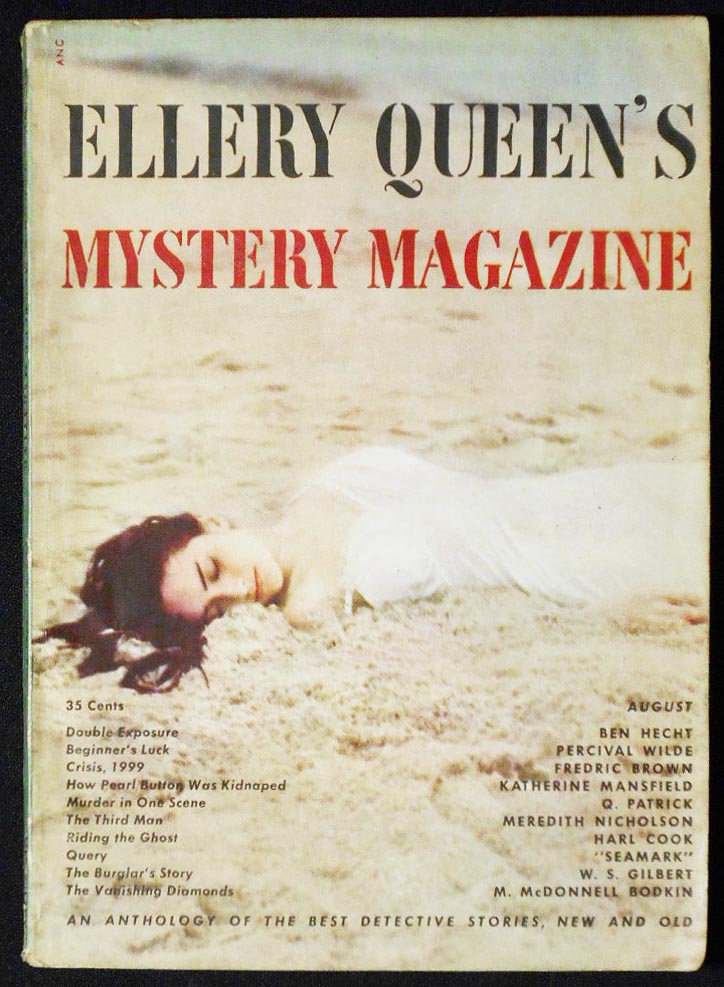Magazine Review: Ellery Queen’s Mystery Magazine August 1949 edited by Ellery Queen
It’s time for another issue of this venerable mystery magazine. The cover this time is uncredited, and does not directly match any of the stories in the issue.

“Double Exposure” by Ben Hecht opens the issue with a tale of a psychiatrist who may have arranged two murders. But is he criminally liable? The story was originally titled “Some Rather Evil People”, but the magazine editor suggested a few changes.
“Crisis, 1999” by Fredric Brown is a science fiction story. Fifty years in the future, lie detectors have become a commonplace in criminal trials. But now the gangsters of Chicago seem to be beating the lie detectors on a regular basis. World’s greatest detective Bela Joad must find out what’s happening. But can even he stop it?
Some amusing bits here about future culture (red suits are inconspicuous, newspapers are microfiches), but the science part of the solution is…dubious.
“How Pearl Button Was Kidnapped” by Katherine Mansfield is a more unusual story, told from the perspective of the small child who is not even aware she’s been abducted. Pearl’s never been to the sea, though she lives within adult walking distance of it, and enjoys her short stay with the dark-skinned people. (Native Americans? Roma? Indigenous Africans? Not enough clues.) The ambiguity gives the story atmosphere, but not much else.
“Riding the Ghost” by Harl Cook is a more standard story, introducing a potential series sleuth. Aristides Papadracopoulos, Art Drake to his friends, is a professional wrestler turned taxicab driver. The title is a reference to running your cab without a passenger (which the taxi company charges the driver for), and to the fact that Art finds himself carting around a corpse.
He doesn’t have a grudge against the dead man that he knows of, but it turns out the corpse has a possible grudge against Art, which makes our protagonist a suspect. Art must use a police detective’s suspicion of him to solve the case. Art is a pretty nice guy who’s willing to throw people credit even if they’re not being pleasant to him.
A decent enough story, but the information about taxicab drivers of the 1940s is the most useful bit.
“Query” by Seamark has a man go to prison for fifteen long years for a murder he did not commit. After being released, the man confronts the prosecutor in the case with absolute proof of his innocence. Or is it absolute proof of his guilt? This one is listed as “a problem story.”
“Speaking of Crime” by Anthony Boucher is the book review column, this time focusing on humorous mysteries from British authors. No books that I recall hearing of before.
“The Third Man” by Meredith Nicolson is unusual in that the detective is the governor of Indiana, who must determine whether to pardon a prisoner convicted of murder. The proceedings take place at a supper club meeting, and some strong resemblance makes me wonder if Nicolson was an influence on Isaac Asimov’s Black Widowers stories. The ending is much more about restoring moral order than solving a clever puzzle, though.
“The Burglar’s Story” by W.S. Gilbert is most notable for being written by that W.S. Gilbert, as in “Gilbert and Sullivan.” An apprentice burglar strikes out on his own after the death of his master. He picks the wrong old man to rob, and pays the humorous consequences.
“Guess Who?” by Talbot C. Hatch is a description of a famous mystery character without some of the most obvious clues. I figured it out within about three paragraphs. The answer was printed upside down just in case anyone missed it.
“Queen’s Quorum: Part Three” by Ellery Queen is part of a chronological list of important mystery writers/stories. This installment takes us from Eden Philpotts to M. McDonnell Bodkin with Arthur Conan Doyle in the middle.
Speaking of Bodkin, the next story is by him, “The Vanishing Diamonds.” His series detective Paul Beck investigates how a set of diamonds vanished between the jeweler’s and a young woman’s home when the sealed case never left her fiance’s hand. There’s a bittersweet ending as Paul must arrest his other self.
“Murder in One Scene” by Q. Patrick finds Lieutenant Trask of the New York Police Homicide Bureau get what initially looks like a piece of junk mail from a dubious charity. But it’s really an invitation to witness murder! Sharp readers will figure out the twist before Trask explains it.
“Beginner’s Luck” by Percival Wilde closes the issue with a long tale involving former cardsharp turned cheat-smasher Bill Parmelee. Except that this time, he’s not accepting a request to go to Florida to investigate gambler Pete Carney. Instead he’s sending his young friend Tony Claghorn to handle the situation.
After all, Tony’s got to have learned something from all the times Bill has bailed him out, right? Of course, Tony is in way over his head, and only his smart wife and the fact that Bill is keeping an eye on things in secret keeps him safe. The story ends about as you’d expect.
“Riding the Ghost” and “The Vanishing Diamonds” were my favorites in this issue, while “Pearl Button” and “Query” were a little lacking. Still, a solid issue. Some of these stories may have been reprinted elsewhere, so happy hunting!

